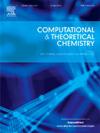A comparative density functional theory (DFT) and molecular dynamics study on Natamycin and Cefmetazole as effective corrosion inhibitor for mild steel: Electronic properties and adsorption behavior
IF 3
3区 化学
Q3 CHEMISTRY, PHYSICAL
引用次数: 0
Abstract
This work investigated the corrosion inhibition mechanism of Natamycin and Cefmetazole on mild steel using Density Functional Theory (DFT) and Molecular Dynamic (MD) simulation. Natamycin exhibited a low HOMO-LUMO energy gap of 0.5 eV and a high adsorption energy of −92.7 kJ/mol which demonstrates its high chemical reactivity for effective adsorption on metal surfaces. The presence of hydroxyl groups and conjugated double bonds in its structure allows for fast electron exchange to generate strongly adhesive protective films. Cefmetazole with HOMO-LUMO gap of 2.45 eV and adsorption energy of −67 kJ/mol with β-lactam and sulfur on the adsorbent surface providing strong hydrogen bonding with the metal atoms. The independence of the generated geometries is additionally supported through MD simulations showing their adsorption configurations when providing the optimal spreading and orientation to block corrosive agents. Natamycin reacted more readily and adsorbed spontaneously, showing its suitability for use in acidic media, whereas, Cefmetazole, in contrast, affords an even inhibition profile, though only of moderate chemical stability. The conclusions also show dispositions of pharmaceutical compounds that may be used as green corrosion inhibitors which comply with the green chemistry roadmap.

本研究利用密度泛函理论(DFT)和分子动力学(MD)模拟研究了纳他霉素和头孢美唑对低碳钢的缓蚀机理。纳他霉素的 HOMO-LUMO 能隙较低,为 0.5 eV,吸附能较高,为 -92.7 kJ/mol。其结构中羟基和共轭双键的存在使其能够快速进行电子交换,从而生成粘性很强的保护膜。头孢美唑的 HOMO-LUMO 间隙为 2.45 eV,吸附能为 -67 kJ/mol,其吸附剂表面的 β-内酰胺和硫能与金属原子形成强氢键。此外,通过 MD 模拟还证明了所生成几何形状的独立性,这些几何形状的吸附构型为阻挡腐蚀剂提供了最佳的铺展和取向。纳他霉素更容易发生反应并自发吸附,这表明它适合在酸性介质中使用,而头孢美唑则相反,虽然化学稳定性一般,但却具有均匀的抑制作用。结论还显示了可用作绿色缓蚀剂的药物化合物的处置方式,这些化合物符合绿色化学路线图的要求。
本文章由计算机程序翻译,如有差异,请以英文原文为准。
求助全文
约1分钟内获得全文
求助全文
来源期刊

Computational and Theoretical Chemistry
CHEMISTRY, PHYSICAL-
CiteScore
4.20
自引率
10.70%
发文量
331
审稿时长
31 days
期刊介绍:
Computational and Theoretical Chemistry publishes high quality, original reports of significance in computational and theoretical chemistry including those that deal with problems of structure, properties, energetics, weak interactions, reaction mechanisms, catalysis, and reaction rates involving atoms, molecules, clusters, surfaces, and bulk matter.
 求助内容:
求助内容: 应助结果提醒方式:
应助结果提醒方式:


